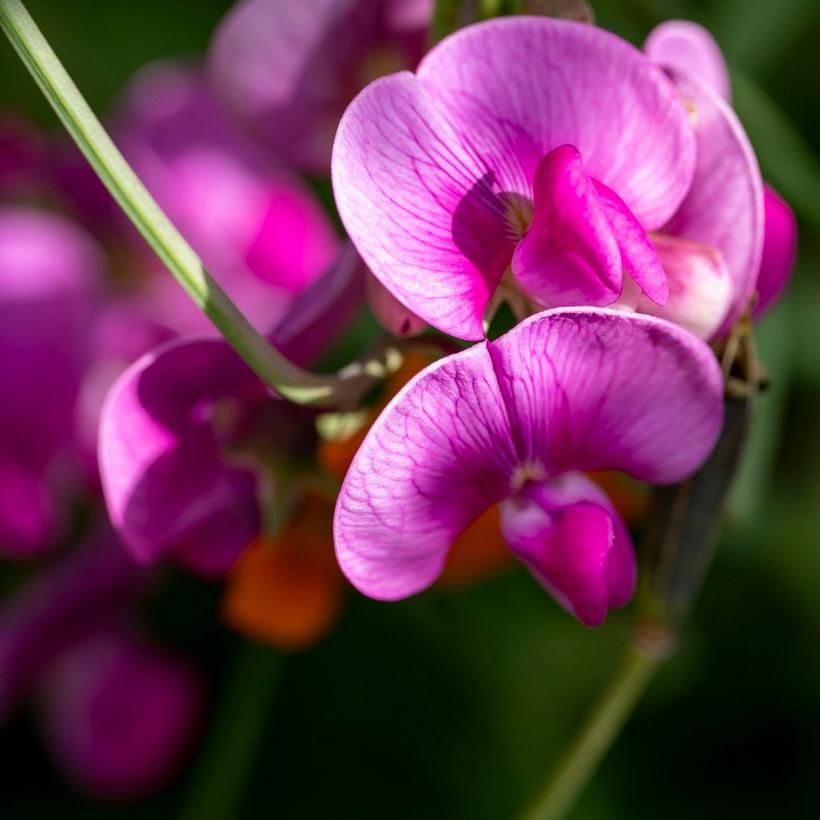The Ultimate Flower Guide to Sweet Peas
Fragrant, frilly and full of colour, summer just wouldn’t be the same without sweet peas. In this ultimate guide we’ll cover everything from their symbolism to their gloriously varied varieties. You'll learn how to look after them and discover some tips for making your own sweet pea display.
An introduction to sweet peas
Botanically known as Lathyrus Odoratus, ‘Lathyrus’ meaning ‘pea’ and ‘Odoratus’ meaning ‘fragrant’, the sweet pea is part of the Lathyrus genus of plants, which includes about 160 species. The sweet pea’s wider family Leguminosae (aka the pea/bean/legume family) includes some edible peas, but it’s important to remember that this sweet flowering pea doesn’t produce the veggies we like and is toxic if eaten.
Growing up to two metres high, sweet peas are climbing plants that like to attach themselves to supports using their tendrils (vine-like shoots off their main stems). Butterfly-shaped blooms spring from individual stems during the sweet pea’s flowering months, and their sweet scent is often compared to a mix of orange blossom, lavender and rose.
While native to eastern Mediterranean countries, today the sweet pea blooms throughout Britain’s sunny summer months with help from UK gardeners.
Sweet pea meaning and symbolism
The sweet pea is said to symbolise many things – including loyalty, friendship and even, pleasure. In Victorian times, sweet peas were often given to say thanks to friends and family for their hospitality, kind of like sending flowers after staying at someone’s house!
Like many flowers, each colour has its own significance too. White sweet peas are a token of peace and innocence, pink for happiness and red for romance, to name a few.
Sweet pea facts
The sweet pea is the birth flower for April along with the daisy.
Poet John Keats was a sweet pea fan, they feature in many of his poems.
You’ll never see a truly yellow sweet pea. Although many have tried, it has yet to be successfully cultivated. The variety ‘Primrose’, a cream-coloured sweet pea, is the closest to it.
Franciscus Cupani, a Sicilian monk, first introduced the sweet pea to England in the late 17th century. There’s even a variety named after him, ‘Cupani’, that’s one of the closest botanically to the original plant.
Perennial varieties of sweet pea do exist, such as Lathyrus Sylvestris and Lathyrus Latifolius. Gardeners love them because the keep coming back, but they rarely have the annual’s perfumed fragrance.
Set up in 1900, The National Sweet Pea Society is still going strong today. For a small fee, you can even become a member.
Types of sweet peas
With a long history of cultivation, there are lots of sweet peas to choose from. Here are a few to get you started…
Lathyrus Odoratus ‘Matucana’
Lathyrus Odoratus 'Kingfisher'
Lathyrus Odoratus ‘St George’
When to plant Sweet Peas
Sow sweet peas in early spring, or for a head start, get sowing in autumn (you’re likely to have stronger plants that’ll bloom a bit earlier). Sweet peas are also available as plug plants (young plants already grown a bit) in early spring if you don’t have time to sow them yourself.
Your seeds will need a warm environment to germinate (begin to grow), like a greenhouse or a windowsill, somewhere you can leave them to grow throughout the winter. Two to three seeds in one small pot should be enough. Plant your sweet peas outside once there’s no chance of frost. It’s also best to harden off sweet peas before planting them in the ground. Hardening off just means leaving them somewhere outside to get used to the colder weather during the day and bringing them back into their sheltered spot in the evening.
Top tip: when your plants have three pairs of leaves, pinch off the tip above the third pair of leaves to encourage them to grow more shoots. More shoots will mean more flowers once they start blooming. There are lots of videos online that show you how to do this.
How to care for sweet peas
Where to put sweet peas
Sweet peas like a sunny area. You can plant them in the ground or they also do very well in pots (just make sure they have good drainage and enough space for their roots to form). Give your sweet peas something to support their tall stems – like ready-made supports (from garden centres or online), or you can make your own frame with wooden sticks, such as bamboo canes. Try and avoid new plastic supports to keep things planet friendly.
How often to water sweet peas
Sweet peas are thirsty flowers, so keep them well watered – watering every day or every other day during the hot summer months. Be careful not to overwater sweet peas, as their leaves will start to turn yellow and wilt. If you’re not sure if you should water them, it’s best to feel the soil yourself and see how dry it is.
Feeding
Plant your sweet peas in fertile soil or if they’re in a pot, use a peat-free multipurpose compost. Once they start producing buds, feed them with a high-potash or comfrey fertiliser every couple of weeks. If you have comfrey growing in your garden, you can even make your own feed. Take a look at this guide from Gardeners’ World to see how.
Deadheading
Remove dead blooms and pick your sweet pea flowers at least once a week (they make great flowers for stem vases). The more you pick, the more sweet pea flowers you’ll get. If you don’t cut your flowers as they bloom, your sweet peas will start to form seed pods and think it’s time to shut down.
When do Sweet Peas bloom?


Creating a sweet pea bouquet
Long-lasting and highly-scented, sweet peas are a great choice for bouquets. Make your own delicate display with our step-by-step guide.







%20(1).jpg?$poi-square$&fmt=auto&qlt=default&fmt.jp2.qlt=60&bg=rgb%28254%2C+204%2C+167%29&w=960&aspect=16%3A9)